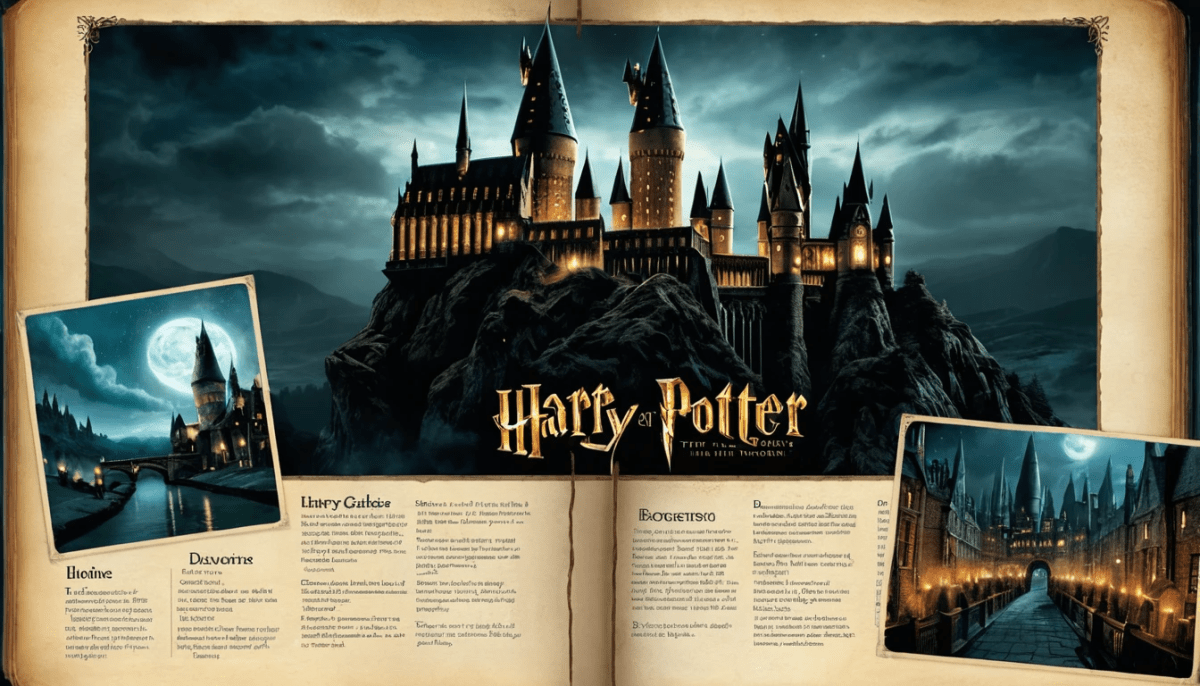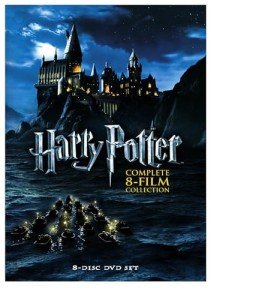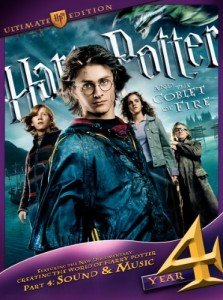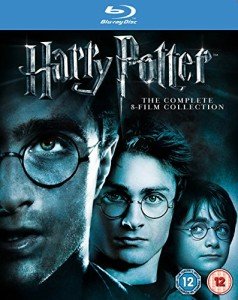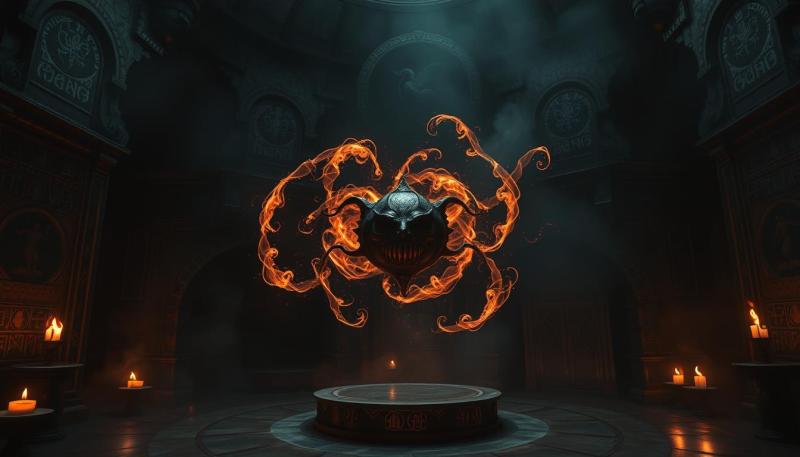Remember the first time you stepped into Hogwarts’ Great Hall through the silver screen? For millions, this iconic film series became more than entertainment—it shaped childhoods and redefined fantasy storytelling. Today, we’re unpacking every spellbinding detail of the franchise that turned Daniel Radcliffe, Rupert Grint, and their castmates into household names.
From its humble start as a book adaptation to becoming a $7.7 billion global phenomenon, these movies broke records and hearts alike. Whether you’re planning a marathon or discovering the magic for the first time, this guide serves as your Marauder’s Map through the wizarding world’s cinematic journey.
We’ll explore how J.K. Rowling’s pages transformed into visual spectacles, why the core cast’s chemistry still resonates, and where you can stream these classics today. You’ll also uncover behind-the-scenes secrets that even hardcore fans might’ve missed!
Key Takeaways
- Complete cinematic journey: Covers all eight films in chronological order
- Cast evolution: Follow Daniel Radcliffe and Rupert Grint’s growth from child stars to icons
- Cultural phenomenon: Understand how the films shaped modern fantasy cinema
- Streaming made easy: Updated platforms where you can watch the series today
- Behind the magic: Production insights and hidden Easter eggs
Introduction: Enter the World of Magic
You’re eleven again, watching letters fly through the Dursleys’ fireplace with wide-eyed awe. That’s the spell Harry Potter and the Philosopher’s Stone cast in 2001—a gateway to floating candles, talking portraits, and a boy destined for greatness. From Emma Watson’s first scene as Hermione Granger, her quick wit and bushy hair became symbols of the series’ charm.
The magic deepened as the films matured. By Potter Deathly Hallows, the whimsy of chocolate frogs gave way to soul-splitting stakes. Remember the eerie silence as Harry walked into the Forbidden Forest? That shift from wonder to wartime defined the saga’s emotional range.
What keeps fans rewatching? It’s the blend of nostalgia and craft. The early movies sparkle with childlike discovery, while later entries like Deathly Hallows showcase groundbreaking effects. We’ll walk through each chapter’s unique flavor—the cozy warmth of Prisoner of Azkaban, the raw intensity of Half-Blood Prince.
This journey isn’t just about reliving memories. It’s about seeing how Emma Watson and her co-stars grew alongside their characters, creating a legacy that still feels fresh. Ready to rediscover the spells? Let’s begin.
The Evolution of Harry Potter: From Books to Movies
Translating 4,224 pages of magic into eight films wasn’t just waving a wand—it required balancing fan expectations with cinematic storytelling. The series’ visual identity shifted dramatically, mirroring the characters’ coming-of-age journeys.
From Philosopher's Stone to Deathly Hallows
Chris Columbus’ 2001 debut captured the books’ whimsy with candy-colored visuals. But by Prisoner of Azkaban, Alfonso Cuarón introduced shadowy cinematography that reflected the story’s maturity. Notice how the Time-Turner sequence gained fluid camera movements missing from earlier installments?
| Aspect | Early Films | Later Films |
|---|---|---|
| Visual Style | Bright, static shots | Dynamic angles |
| Character Depth | Simpler arcs | Complex motivations |
| Themes | Childlike wonder | Moral ambiguity |
Book vs. Film Adaptations
While Half-Blood Prince condensed subplots about Voldemort’s past, it expanded romantic tensions through lingering glances. The films often prioritized visual storytelling—like showing Snape’s memories instead of explaining them through dialogue.
Three key adaptation strategies emerged:
- Streamlined narratives: Cutting minor characters like Peeves
- Visual enhancements: Making magic more kinetic
- Tonal shifts: Darkening humor for older audiences
The Fantastic Beasts spin-offs later tested how far the universe could stretch beyond its source material. While controversial, they proved Rowling’s world-building could thrive beyond printed pages.
Harry Potter Complete 8-Film DVD Collection
Experience all the magic and adventure of the wizarding world from beginning to end with this ultimate DVD collection
Product information
SGD 19.12
Product Review Score
4.44 out of 5 stars
93 reviewsProduct links
Harry Potter List of Movies
Let’s chart the eight-film adventure that transformed bedtime stories into box office history. Each chapter builds on the last, creating a tapestry of magic that grows richer with every rewatch.
- The Philosopher’s Stone (2001)
- Where it all began. Chris Columbus introduces us to Hogwarts with snow-globe charm, setting the visual template for magical education. Perfect for first-time viewers discovering quidditch and chocolate frogs.
- Chamber of Secrets (2002)
- Darker tones emerge as Tom Riddle’s diary unleashes Slytherin’s monster. This installment cemented the trio’s loyalty while introducing key elements like apparition and polyjuice potions.
- Prisoner of Azkaban (2004)
- Alfonso Cuarón’s game-changer. Watch the visual style mature alongside the characters, with time-twisting sequences that still leave fans debating timelines.
- Goblet of Fire (2005)
- The Triwizard Tournament explodes onto screen with dragon battles and underwater challenges. Mike Newell balances spectacle with emotional beats like Cedric’s tragic fate.
- Order of the Phoenix (2007)
- David Yates’ debut brings political urgency as the Ministry denies Voldemort’s return. Look for that Department of Mysteries duel—a CGI milestone that raised the action bar.
Later entries like Half-Blood Prince and the Deathly Hallows duology would push boundaries further, but these first five films established the saga’s DNA. Notice how Chamber of Secrets’ basilisk hunt contrasts with Goblet of Fire’s arena-scale conflicts?
We’ll explore each title’s hidden details in upcoming sections—from Order of the Phoenix’s guerrilla journalism subplot to the evolving strategies behind magical combat scenes. Which film’s aesthetic speaks most to your inner witch or wizard?
Release Order vs. Chronological Order
Ever wondered if you're missing hidden layers by watching the films as they premiered? Here's the twist: unlike franchises with prequels or timeline jumps, the wizarding saga unfolds identically in both release and story sequence. This unique consistency means first-time viewers and marathoners experience the same progression from Philosopher's Stone to Deathly Hallows.
Why Order Matters in a Linear Saga
Take Chamber of Secrets—its mystery about Tom Riddle’s diary gains urgency when watched after the first film. Similarly, Goblet of Fire’s tournament stakes feel higher when you’ve seen prior friendships develop. The series’ deliberate pacing rewards those following the intended journey.
| Aspect | Release Order | Chronological |
|---|---|---|
| Narrative Flow | Builds suspense naturally | Mirrors book structure |
| Character Growth | Shows gradual maturation | Highlights foreshadowing |
| Twist Impact | Preserves surprises | Reveals hidden connections |
Newcomers should stick to release order to preserve reveals like Snape’s true motives in Half-Blood Prince. Rewatchers might spot early clues about horcruxes in Chamber of Secrets that gain significance later. The Deathly Hallows duology especially benefits from seeing prior setups pay off.
While some franchises demand order debates, here the choice becomes about perspective. Release order lets the story unfold as intended, while chronological viewings (identical here) let you appreciate Rowling’s planted seeds. Either way, you’re in for magic.
Film Summaries: A Glimpse into Each Chapter
There’s a moment in every fan’s life when Platform 9¾ becomes more than fiction—it’s a portal to growth. Let’s unpack how the series evolves from cozy mysteries to war-torn reckonings, all while keeping its spellbinding heart.
Where Magic Found Its Footing
The first three films feel like finding hidden rooms in a castle. Philosopher’s Stone introduces wonder through floating feathers and three-headed dogs. By Chamber of Secrets, darker threads emerge—basilisk attacks and Tom Riddle’s diary test the trio’s bond.
Prisoner of Azkaban shifts gears visually and emotionally. Those time-loop sequences? They’re not just clever—they teach us about consequences. Notice how the Dementors’ arrival mirrors Harry’s teenage angst? That’s storytelling alchemy.
When Shadows Overtook the Castle
Post-Goblet of Fire, the stakes turn deadly serious. Order of the Phoenix pits students against a corrupt Ministry, with Umbridge’s pink tyranny symbolizing real-world authoritarianism. The Department of Mysteries battle isn’t just flashy—it’s the first domino in Voldemort’s return.
Potter Half-Blood Prince deepens the darkness with love potions and cave horrors. But it’s the Deathly Hallows duology that seals the saga’s legacy. Forest showdowns and Elder Wand loyalties test every relationship built over seven films.
From Chamber of Secrets’ whispers to Order of the Phoenix’s rebellion, these summaries reveal patterns you’ll spot in later analyses. Ready to explore what makes each chapter click?
Deep Dive: Iconic Moments and Key Scenes
Some movie moments cling to your memory like a Patronus in the dark. The potter films overflow with scenes that redefined fantasy storytelling—from wand duels that crackled with tension to quiet revelations that changed everything. Let’s unpack why these sequences still give fans goosebumps decades later.
Memorable Battles and Magical Twists
Remember the Ministry of Magic showdown in Order of the Phoenix? Death Eaters versus Dumbledore’s Army—a chaotic ballet of spells that showed teenagers becoming soldiers. This clash wasn’t just flashy effects; it marked the war’s brutal start.
Then there’s Snape’s pensieve revelation in Deathly Hallows. Alan Rickman’s delivery of “Always” transformed a villain into a tragic hero. These twists weren’t just surprises—they recontextualized entire year hogwarts arcs upon rewatch.
The Battle of Hogwarts remains unmatched. Stone statues awakening, giants smashing walls, and Molly Weasley’s iconic “Not my daughter!” roar. As noted in this breakdown of pivotal scenes, the final Voldemort duel’s silent tension—where wand beams intertwine like battling serpents—became the saga’s visual exclamation point.
Smaller moments shine too. The Prisoner of Azkaban time-turner sequence turns a clockwork puzzle into emotional payoff. Notice how the Whomping Willow’s seasons change in seconds? That’s the magic of showing year hogwarts rhythms through visuals rather than dialogue.
From the Triwizard Tournament’s dragon chase to Dobby’s heartbreaking sacrifice, these scenes work because they blend spectacle with character. Every phoenix flight and hidden horcrux feels earned—proof that the potter films knew when to dazzle and when to let silence speak.
Casting & Character Highlights in the Films
Casting directors didn’t need magic to foresee that Daniel Radcliffe’s piercing gaze would define a generation’s idea of heroism. The films’ soul lies in its ensemble—a perfect storm of rookie talent and seasoned actors who became their characters. Let’s unpack how these choices shaped cinematic history.
Iconic Performances of the Trio
Radcliffe, Watson, and Grint grew up on screen, their chemistry evolving from awkward first takes to electric rapport. Watson’s Hermione became a feminist icon through subtle choices—like adjusting her posture during potter order rebellion scenes. Grint’s comedic timing in potter goblet balanced darker plot twists, proving Ron’s heart mattered as much as his humor.
Behind-the-scenes stories reveal the magic. Did you know Radcliffe almost lost the role? His parents initially refused filming commitments. Yet that raw vulnerability in secrets dumbledore flashbacks? Pure instinct honed over a decade.
Supporting Characters and Their Legacy
Alan Rickman’s Snape remains unmatched—a masterclass in layered acting. His whispered “Always” in crimes grindelwald-era interviews still gives fans chills. Maggie Smith’s McGonagall blended steel and warmth, while Richard Harris’ Dumbledore in early films set the template for wise mentors.
Newcomers often miss how potter order supporting roles influenced later fantasy. The Weasley twins’ chaotic energy inspired Marvel’s quippy heroes. Even potter goblet’s Mad-Eye Moody became a blueprint for gritty warrior mentors in shows like The Witcher.
From crimes grindelwald spin-offs to theme park attractions, these characters outlived their pages. Their secret? Casting that prioritized emotional truth over lookalikes—a spell every franchise since has tried to replicate.
Harry Potter: Goblet of Fire Ultimate Edition
Dive into the magical world of Hogwarts with exclusive features and behind-the-scenes content
Product information
SGD 71.64
Product Review Score
4.82 out of 5 stars
171 reviewsProduct links
Behind the Scenes: Directorial Visions
Have you ever noticed how each film feels distinct yet unified? That’s the magic of visionary directors leaving their fingerprints on the wizarding world. From Chris Columbus’ storybook beginnings to David Yates’ shadowy finales, these creators shaped how we experience magic.
Distinctive Directing Styles of the Franchise
Columbus set the template with potter chamber’s cozy mystery vibe. His static shots made Hogwarts feel like a snow globe—safe and wondrous. But watch how Alfonso Cuarón’s Prisoner of Azkaban swirls cameras around time-traveling heroes. Those Dutch angles? Pure cinematic rebellion.
Mike Newell’s goblet fire brought blockbuster spectacle. Remember the dragon chase’s shaky cam? It made you feel Harry’s adrenaline. Then Yates took over, using desaturated tones in later movies to mirror wartime bleakness. His death eaters attacks felt less like fantasy and more like documentaries of chaos.
| Director | Visual Style | Color Palette | Key Scene |
|---|---|---|---|
| Chris Columbus | Static, symmetrical | Warm primaries | Great Hall feasts |
| Alfonso Cuarón | Dynamic tracking | Muted earth tones | Time-Turner sequence |
| David Yates | Gritty close-ups | Cool grays | Battle of Hogwarts |
Yates’ boldest choice? Filming Voldemort’s death in slow-mo ash. No flashy spell—just poetic collapse. These movies thrived by letting directors innovate while honoring Rowling’s core. Whether it’s goblet fire’s Yule Ball glam or potter chamber’s creeping basilisk terror, each vision expanded what fantasy could be.
The death eaters’ London attack in Half-Blood Prince shows this evolution. Early films would’ve cut away—Yates forces us to watch bridges snap like twigs. That’s the franchise’s legacy: directors who made magic feel real, risky, and relentlessly human.
Critics' and Fans' Reactions Over Time
Did your heart race when the credits rolled on Deathly Hallows Part 2? You weren’t alone. The series sparked passionate debates between critics and fans, with Rotten Tomatoes scores swinging from 81% (Philosopher’s Stone) to a peak 96% for the finale. But numbers only tell half the story.

From Warm Welcome to Sky-High Expectations
Early films charmed critics with their book-accurate whimsy, though some called them “too safe.” By Order of the Phoenix, reviews split: “A bold shift into political drama,” praised The Guardian, while others missed the lighter tone. The finale silenced doubters—its 96% critic score still ranks among fantasy’s highest.
Fans evolved too. Initial excitement about movies staying true to novels gave way to heated debates. Remember the outrage over Half-Blood Prince cutting key memories? Yet scenes like Snape’s “Always” speech became cultural touchstones, proving adaptations could enhance the source material.
“The emotional payoff of Hallows Part 2 redefined what blockbusters could achieve.”
Three trends shaped reactions:
- Growing critical respect as themes matured
- Fan forgiveness for creative changes in later movies
- Reassessment of early entries as nostalgic classics
While Fantastic Beasts spinoffs divided audiences, the core series maintains its 85% average audience score on Rotten Tomatoes—a testament to enduring magic. Whether you first watched them in release order or binged later, these films keep casting new spells.
Magical Music and Special Effects in the Series
Close your eyes. Can you hum Hedwig’s Theme? That soaring celesta melody didn’t just introduce a boy wizard—it became the audio signature of a generation. Behind every flick of a wand or flutter of a golden snitch lay technical wizardry that made magic feel tangible.
Innovations That Brought the Wizarding World to Life
The film series’ soundscape evolved like a symphony. Early scores by John Williams sparkled with childlike wonder, while Alexandre Desplat’s later work in Deathly Hallows throbbed with wartime urgency. Sound designers even recorded real bees for dementor noises—a chilling detail that made threats feel visceral.
| Element | Early Films | Later Films |
|---|---|---|
| Visual Effects | 60% practical | 80% CGI |
| Music Style | Orchestral whimsy | Electronic fusion |
| Sound Design | Book-accurate | Emotion-driven |
Groundbreaking moments redefined fantasy cinema. The basilisk in Chamber of Secrets used animatronics so detailed, actors genuinely recoiled. By 2011, Deathly Hallows Part 2’s crumbling Hogwarts required 588 VFX shots—each frame a blend of miniatures and digital artistry.
“Williams’ theme isn’t just music—it’s a Portkey to childhood wonder.”
Notice how dragon roars in Goblet of Fire mixed tiger growls with subway screeches? Or how the beasts in Fantastic Beasts moved like real animals? These choices made magic feel lived-in. Even quidditch matches gained depth through Doppler-effect broom whooshes.
From the full film series’ first spell to its last, technical artistry proved magic isn’t just about what you see—it’s what you feel vibrating in your bones.
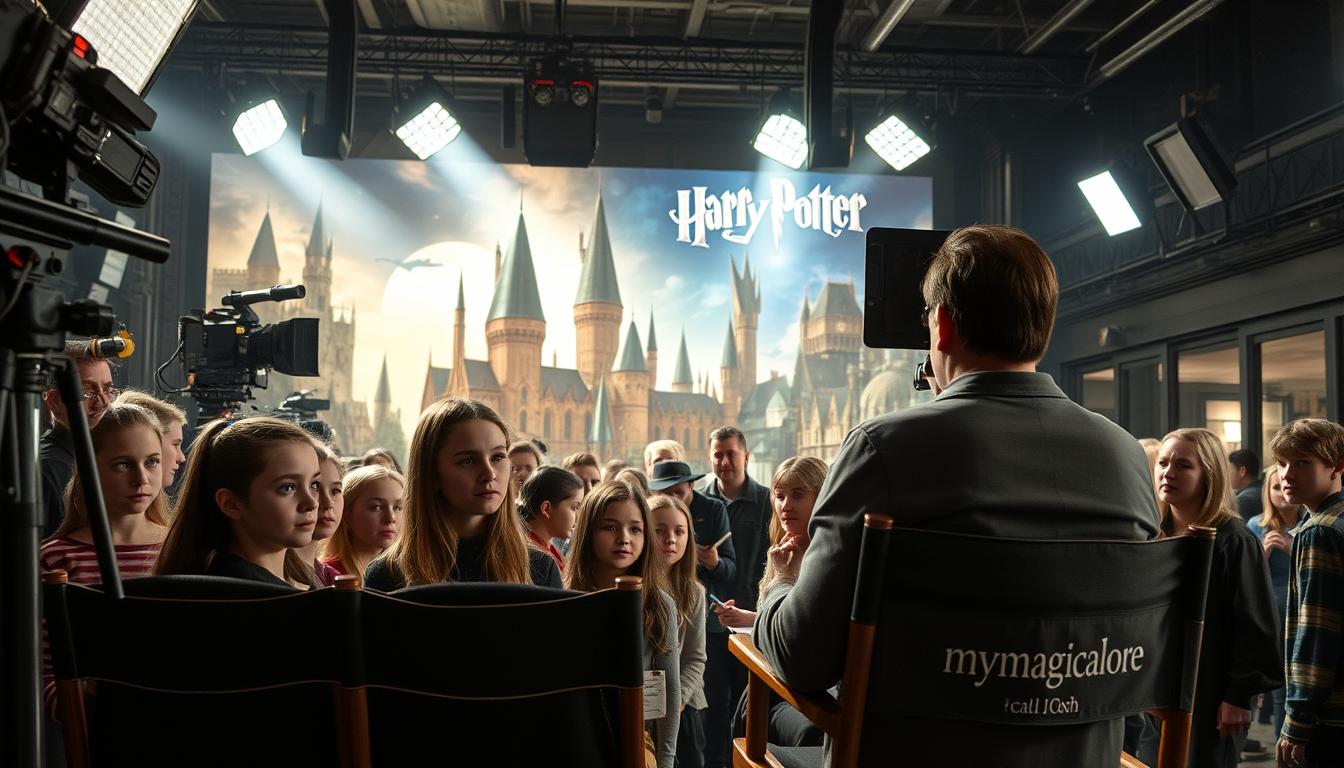
Cultural Impact and Legacy of the Wizarding World
What does it take for a story to rewrite the rules of global storytelling? The films didn’t just entertain—they sparked a cultural revolution. Theme parks, fan conventions, and college courses now dissect the series’ themes, proving magic isn’t confined to screens.
Redefining Fantasy’s Blueprint
Before 2001, fantasy films often targeted niche audiences. The franchise’s success proved magical stories could dominate box offices and dinner conversations. Studios rushed to replicate its formula: young heroes, intricate lore, and merch-ready creatures. Can you name a modern fantasy that doesn’t borrow from Hogwarts’ playbook?
Three key trends emerged:
- Fandom as identity: House quizzes and wand purchases became rites of passage
- Binge-worthy lore: Complex mythologies in shows like Stranger Things
- Thematic maturity: Kids’ stories tackling prejudice and mortality
| Pre-Potter Fantasy | Post-Potter Era |
|---|---|
| Standalone films | Expanded universes |
| Simple good vs. evil | Moral gray areas |
| Limited merch lines | Global retail empires |
Even news cycles bend to the world’s spell. From Broadway’s Cursed Child to TikTok fan theories, the saga stays relevant by evolving. Remember when #HogwartsLegacy trended for weeks? That’s legacy in action—new generations claiming the magic as theirs.
As one critic noted:
“The series didn’t just reflect culture—it became the lens through which we view heroism, friendship, and resilience.”
While other films fade, this world thrives because it’s more than escapism. It’s a mirror showing our best selves—brave enough to face dark forests, wise enough to value love over power. And that’s a spell no news cycle can break.
Streaming Options and Viewing Guide for U.S. Audiences
What’s better than butterbeer on a Friday night? A perfectly planned marathon of the films that defined a generation. Let’s break down where to stream them today and how to elevate your watch party from ordinary to extraordinary.
Max vs. Peacock: Where to Watch
As of 2024, two platforms duel for your wizarding binge: Max hosts all eight films in 4K UHD with extended cuts, while Peacock bundles them with Fantastic Beasts spinoffs. Here’s the breakdown:
| Feature | Max | Peacock |
|---|---|---|
| Video Quality | 4K HDR | 1080p |
| Bonus Content | Behind-the-scenes docs | Cast interviews |
| Extra Content | None | +5 Fantastic Beasts films |
Max wins for purists craving pristine visuals and deleted scenes from the original franchise. Peacock’s cheaper Premium tier ($5.99/month) suits casual fans exploring the wider wizarding world.
Harry Potter: Illustrated Chamber of Secrets Edition
Step into the magical world of Hogwarts with stunning illustrations that bring the charm of the Chamber of Secrets to life
Product information
SGD 52.10 SGD 31.37
Product Review Score
4.76 out of 5 stars
219 reviewsProduct links
Tips for a Magical Viewing Experience
Transform your living room into the Great Hall with these pro tips:
- Sync snacks to scenes: Treacle tart during feasts, pumpkin juice for quidditch matches
- Use intermissions between films to debate house loyalties or trivia (“Name all Horcruxes!”)
- Enable subtitles to catch whispered spells you’ve missed before
Don’t skip the special features! Max’s “Creating the World” documentaries reveal how books became cinematic magic. For group viewings, try a weekend split: lighter early films Friday, darker chapters Saturday.
“Streaming these classics lets new fans discover the franchise while veterans spot fresh details in 4K.”
Conclusion
Few stories leave footprints across generations like this saga. Over two decades, its magic evolved from whimsical beginnings to groundbreaking narratives that redefined fantasy cinema. You’ve journeyed with us through innovative adaptations, cultural milestones, and behind-the-scenes wizardry that turned pages into timeless art.
The series’ legacy thrives not just in box office records, but in how it shaped modern fandom. From theme parks to Crimes of Grindelwald debates, these tales remain alive through passionate viewers. Newcomers and veterans alike find fresh layers—whether spotting foreshadowing in early scenes or debating the Crimes trilogy’s moral complexities.
Ready to reignite your love for this world? Grab your wand and explore our definitive viewing order guide. Share it with friends who’ve yet to discover flying cars or patronus charms. After all, great stories don’t end—they wait for the next reader to whisper, “lumos.”
As the Crimes spin-offs prove, the wizarding universe keeps expanding. But its heart remains where it began: in characters who taught us bravery isn’t the absence of fear, but the choice to keep going. Here’s to many more years of rewatching, rewinding, and remembering why we fell under the spell.
